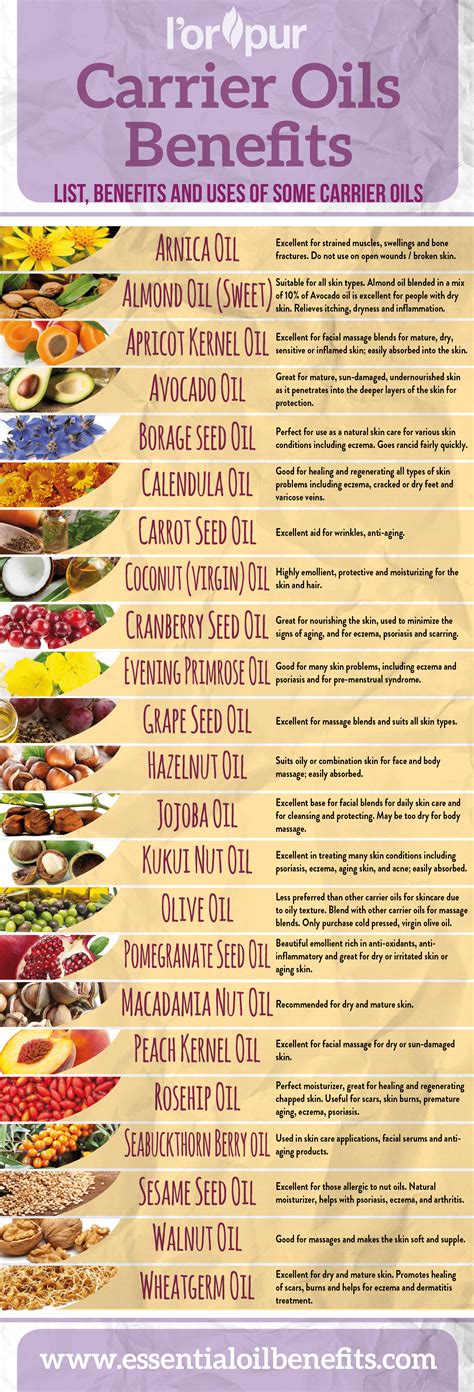Essential oils, extracted from plants, have gained immense popularity due to their therapeutic properties and wide applications. However, directly applying essential oils to the skin can cause irritation or allergic reactions. This is where carrier oils come into play. They act as a diluting agent, reducing the concentration of essential oils and making them safer for topical use.

Key Points to Remember: Essential Oil Carrier Oil Ratio and Applications
Essential Oil Carrier Oil Ratio:
- Generally, the recommended dilution ratio for essential oils is 2-5% in carrier oil.
- For sensitive skin, aim for a lower concentration (2-3%).
- For stronger essential oils, opt for a higher concentration (4-5%).
Popular Carrier Oils:
- Jojoba Oil: Rich in vitamins and antioxidants, it mimics the skin’s natural sebum.
- Coconut Oil: Contains antibacterial and antifungal properties, but can be comedogenic for some.
- Sweet Almond Oil: Gentle and hypoallergenic, suitable for all skin types.
- Argan Oil: Packed with nutrients and antioxidants, it’s ideal for aging skin.
- Grapeseed Oil: Lightweight and non-greasy, it’s great for oily skin.
Top 5 Benefits of Using Essential Oil Carrier Oil
- Enhanced Absorption: Diluting essential oils in carrier oil allows them to penetrate the skin more effectively.
- Reduced Irritation: Carrier oils help soothe and protect the skin, minimizing potential reactions to essential oils.
- Extended Longevity: Carrier oils slow down the evaporation rate of essential oils, making them last longer.
- Versatility: Carrier oils can be used in various applications, including aromatherapy, massage, skincare, and haircare.
- Customization: By blending different carrier oils and essential oils, you can create custom blends tailored to your specific needs.
4 Easy Steps to Use Essential Oil Carrier Oil
- Determine the desired dilution ratio (2-5%).
- Choose a suitable carrier oil based on your skin type and preferences.
- Add the essential oil(s) to the carrier oil and stir thoroughly.
- **Apply the diluted mixture to the desired area as per the instructions for the specific essential oil.
9 Practical Applications of Essential Oil Carrier Oil
Pain Relief:
* Blend peppermint or eucalyptus oil with coconut oil for muscle aches.
* Use lavender or chamomile oil in jojoba oil for headaches.
Skincare:
* Mix tea tree oil with grapeseed oil for acne-prone skin.
* Dilute rosehip oil in argan oil to reduce wrinkles and scars.
Haircare:
* Combine rosemary oil with coconut oil to promote hair growth.
* Use lavender or ylang-ylang oil in jojoba oil as a hair conditioner.
Aromatherapy:
* Diffuse lavender oil in jojoba oil to relax and reduce stress.
* Add lemon or peppermint oil to coconut oil for an invigorating scent.
Massage:
* Mix eucalyptus or ginger oil with sweet almond oil for a stimulating massage.
* Dilute frankincense or myrrh oil in jojoba oil for a relaxing massage.
6 Things to Consider When Choosing an Essential Oil Carrier Oil
- Skin Type: Choose a carrier oil that suits your skin type (e.g., jojoba oil for dry skin, grapeseed oil for oily skin).
- Shelf Life: Opt for carrier oils with a longer shelf life to avoid spoilage and extend the lifespan of your blends.
- Absorption Rate: Consider the absorption rate of the carrier oil to determine how quickly it will deliver the essential oils to the skin.
- Aroma: Choose a carrier oil with a neutral or complementary aroma to enhance the scent of the essential oils.
- Comedogenicity: For acne-prone skin, opt for non-comedogenic carrier oils (e.g., jojoba oil, grapeseed oil).
- Personal Preference: Ultimately, choose a carrier oil that you find pleasant to use and that meets your specific needs.
4 Useful Tables for Essential Oil Carrier Oil Usage
Table 1: Essential Oil Dilution Chart
| Essential Oil | Dilution Ratio |
|---|---|
| Peppermint | 2-3% |
| Lavender | 2-5% |
| Tea Tree | 2-5% |
| Rosemary | 2-4% |
| Frankincense | 2-3% |
Table 2: Carrier Oil Properties
| Carrier Oil | Benefits |
|---|---|
| Jojoba Oil | Mimics skin’s natural sebum, non-comedogenic |
| Coconut Oil | Antibacterial, antifungal, moisturizing |
| Sweet Almond Oil | Hypoallergenic, suitable for all skin types |
| Argan Oil | Rich in antioxidants, anti-aging |
| Grapeseed Oil | Lightweight, non-greasy, suitable for oily skin |
Table 3: Essential Oil Applications
| Application | Essential Oil Blends |
|---|---|
| Pain Relief | Peppermint + Coconut Oil, Eucalyptus + Coconut Oil |
| Skincare | Tea Tree + Grapeseed Oil, Lavender + Jojoba Oil |
| Haircare | Rosemary + Coconut Oil, Lavender + Ylang-Ylang + Jojoba Oil |
| Aromatherapy | Lavender + Jojoba Oil, Lemon + Coconut Oil |
| Massage | Eucalyptus + Sweet Almond Oil, Frankincense + Jojoba Oil |
Table 4: Essential Oil Safety Tips
| Tip | Reason |
|---|---|
| Do a patch test before applying to a larger area | To check for allergies or skin reactions |
| Avoid applying undiluted essential oils directly to the skin | To prevent irritation or burning |
| Follow the recommended dilution ratios | To ensure safety and avoid potential harm |
| Store essential oils and carrier oils in a cool, dark place | To preserve their potency and extend their shelf life |
| Consult a healthcare professional before using essential oils if you have any health conditions | For personalized guidance and to avoid contraindications |
